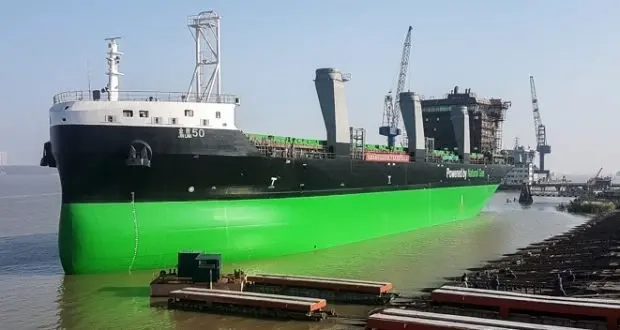ESL launches second LNG-fueled dry cargo vessel

ESL Shipping announced that its second LNG-powered, energy efficient dry cargo vessel ‘Haaga’ was launched on October 20, at the Jinling Shipyard and moved to the outfitting quay.
The ship was named after a place in Helsinki, in accordance with the company’s tradition, in late September.
Haaga’s sister vessel, Viikki, was launched at the end of August, at the same shipyard, becoming the first LNG-powered handyzise bulk carrier in the world.
The 160-meter vessels of 25,600 dwt, fueled by liquefied natural gas, produce more than 50% lower carbon dioxide emissions than vessels of the previous generation, the company claims.
Both ships will start operating on the Baltic Sea during the first half of 2018. This construction project is part of the Bothnia Bulk project, partly funded by the EU, aiming to modernize the sea route between Luleå, Oxelösund and Raahe to be more eco-friendly.
The Action upgrades the existing maritime link between core (Luleå) and comprehensive (Raahe, Oxelösund) ports in the Baltic Sea, to further comply with the environmental regulations such as MARPOL Annex VI and Directive 2012/33/EU.
The main objective of the Action is to have an energy-efficient, low-emission supply of dry bulk cargo available year-round in the peripheral region, to increase port efficiency and reduce overall logistics costs.
The following activities will be carried out:
- Procurement of additional environmental efforts for two new build bulk carriers;
- development of port infrastructure and efficiency in the Port of Raahe;
- development of an on-shore power supply in port;
- development of LNG availability and safe bunkering procedures;
- ex-post climate change impact assessment.
The action promotes clean shipping and alternative fuels. It will increase the demand for LNG and deployment of LNG bunkering infrastructure in the Gulf of Bothnia, as well as the implementation of shore-side electricity.
The total cost of the action is estimated at €22,536,000 and the maximum EU contribution at €6,800,000.
















![AIRBUS A380 [MORE THAN 600 PASSENGER’S CAPACITY PLANE]](https://cdn.tinn.ir/thumbnail/4jCp4EQvCU0b/IjHVrSYQrIAqIzXuTzADR7qLYX4idQT4nfq__26E5SCUPLMqfhWkWajvuO9Wfq1ql1TjV4dhkrHliNQU82kMpo2NNftT_NGEwHc9KXtN_rk731bmifa2IQ,,/airbus-a380-structure1.jpg)

Send Comment